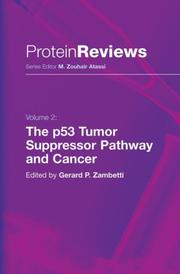| Listing 1 - 5 of 5 |
Sort by
|
Book
ISBN: 9781621821335 Year: 2016 Publisher: Cold Spring Harbor, New York : Cold Spring Harbor Laboratory Press,
Abstract | Keywords | Export | Availability | Bookmark
 Loading...
Loading...Choose an application
- Reference Manager
- EndNote
- RefWorks (Direct export to RefWorks)
p53 protein. --- Tumor suppressor proteins --- Protéine p53 --- Protéines suppresseurs de tumeurs
Book
ISBN: 1461436753 9786613935007 1461436761 1283622556 Year: 2012 Publisher: New York : Springer,
Abstract | Keywords | Export | Availability | Bookmark
 Loading...
Loading...Choose an application
- Reference Manager
- EndNote
- RefWorks (Direct export to RefWorks)
With over 60,000 referenced publications, p53 has emerged as one of the most important factors in human cancer. Research on p53 has led to a complete overhaul of our understanding of the molecular basis of human cancer. In recent years, these major advances in knowledge are starting to impact on cancer management and therapy. This book thus captures a critical turning point in p53 research, from basic to translational research and clinical application. p53 in the Clinics follows the success of 25 Years of p53 Research and condensates in a series of authoritative chapters the considerable progress on the applications of p53 into the clinics and the substantial advances on diseases caused by inheritance of p53 defects, on somatic p53 mutations as biomarkers in molecular pathology, on progress in gene therapy and on developments of innovative drugs and clinical trials. This volume will appeal to a wide audience of students and professionals in basic and clinical cancer research and treatment, and will highlight the exciting “next steps” in p53 research and applications.
p53 antioncogene. --- p53 protein. --- Protein p53 --- Protein TP53 --- TP53 protein --- p53 gene --- p53 suppressor gene --- Medicine. --- Cancer research. --- Pharmacology. --- Biomedicine. --- Cancer Research. --- Pharmacology/Toxicology. --- DNA-binding proteins --- Phosphoproteins --- Tumor suppressor proteins --- Antioncogenes
Book
ISBN: 1441982302 1441982310 Year: 2010 Publisher: Austin, Tex. : New York, New York : Landes Bioscience ; Springer Science+Business Media,
Abstract | Keywords | Export | Availability | Bookmark
 Loading...
Loading...Choose an application
- Reference Manager
- EndNote
- RefWorks (Direct export to RefWorks)
Our understanding of human cancer in the past 40 years has been driven by linking innovative concepts and cutting edge technologies to key problems identified by clinical research. Some of the successes in cancer genetics identified from clinical work have been the identification of specific gene deletions in human chromosomes, the use of PCR-based cloning methodologies to identify and clone human cancer genes, the validation of the human cancer genes using transgenetic technologies in the mouse, and the ability to sequence whole genomes that has recently allowed a collation of all somatic and germline mutations in a human genome. In the same generation, entirely different disciplines involved in basic life science research have used model organisms like yeast, flies, worms, and cancer causing animal viruses as tools to develop windows to see into the machinery of the cell life cycle. The discoveries of pro-apoptotic genes, oncogenes, and covalent control mechanisms like phosphorylation and ubiquitination using the tools of science and technology have all been awarded Nobel prizes for their contribution to our understanding of how cells work. The discovery of p53 using the tumor causing animal virus SV40 falls into this pioneering period of biological and medical research.
Cell Transformation, Neoplastic -- genetics. --- Genes, p53. --- p53 antioncogene. --- p53 protein. --- p53 antioncogene --- p53 protein --- Neoplastic Processes --- Biology --- Genes, Tumor Suppressor --- Biological Science Disciplines --- Genes, Neoplasm --- Pathologic Processes --- Genes, Recessive --- Neoplasms --- Natural Science Disciplines --- Pathological Conditions, Signs and Symptoms --- Genes --- Diseases --- Genome Components --- Disciplines and Occupations --- Genome --- Genetic Structures --- Genetic Phenomena --- Phenomena and Processes --- Genetics --- Genes, p53 --- Cell Transformation, Neoplastic --- Medicine --- Health & Biological Sciences --- Oncology --- Protein p53 --- Protein TP53 --- TP53 protein --- p53 gene --- p53 suppressor gene --- Medicine. --- Cancer research. --- Biomedicine. --- Cancer Research. --- Cancer research --- Clinical sciences --- Medical profession --- Human biology --- Life sciences --- Medical sciences --- Pathology --- Physicians --- DNA-binding proteins --- Phosphoproteins --- Tumor suppressor proteins --- Antioncogenes --- Oncology. --- Tumors

ISBN: 1588291065 9786610842810 1280842814 1592594085 Year: 2003 Volume: 234 Publisher: Totowa, NJ : Humana Press : Imprint: Humana,
Abstract | Keywords | Export | Availability | Bookmark
 Loading...
Loading...Choose an application
- Reference Manager
- EndNote
- RefWorks (Direct export to RefWorks)
Since the discovery of p53 as a tumor suppressor, numerous methods have evolved to reveal its unique structural features and biochemical functions. In p53 Protocols, Sumitra and Swati Palit Deb have assembled an indispensable collection of novel techniques that have proven most useful for studying the physiological properties of p53 both in vitro and in vivo. Described by leading basic and clinical researchers who have successfully used the methods, the techniques provide proven solutions to problems in studying the purification, target identification, gene expression, quantitation, interaction, signaling, transactivation, and transrepression of p53. The methods are also useful for delineating the functions of other proteins that may act as tumor or growth suppressors. Each technique includes step-by-step instructions, troubleshooting notes, a theoretical review, and discussion of associated problems that might arise during the course of investigation. Special effort has been made to discuss problems and their solutions to help ease the learning curve when standardizing a new method. Diverse and highly practical, p53 Protocols offers both beginning and experienced researchers in cancer biology a gold-standard compendium of readily reproducible techniques for studying p53 and related proteins.
Protein p53 --- Tumor Suppressor Proteins --- Genes, p53 --- Neoplasms --- p53 protein --- p53 antioncogene --- Protéine p53 --- Gène p53 --- analysis --- therapeutic use --- physiology --- genetics --- Laboratory manuals --- Manuels de laboratoire --- Electronic books. -- local. --- p53 antioncogene -- Laboratory manuals. --- p53 protein -- Laboratory manuals. --- Tumor Suppressor Protein p53 --- Genetics --- Physiology --- Biological Science Disciplines --- Phosphoproteins --- DNA-Binding Proteins --- Biology --- Genes, Tumor Suppressor --- Nuclear Proteins --- Neoplasm Proteins --- Diseases --- Proteins --- Genes, Recessive --- Natural Science Disciplines --- Genes, Neoplasm --- Disciplines and Occupations --- Amino Acids, Peptides, and Proteins --- Genes --- Chemicals and Drugs --- Genome Components --- Genome --- Genetic Structures --- Genetic Phenomena --- Phenomena and Processes --- Animal Biochemistry --- Cytology --- Human Anatomy & Physiology --- Health & Biological Sciences --- Protéine p53 --- Gène p53 --- p53 gene --- p53 suppressor gene --- Antioncogenes --- Protein TP53 --- TP53 protein --- DNA-binding proteins --- Tumor suppressor proteins --- analysis. --- physiology. --- genetics. --- Cytology. --- Cell Biology. --- Cell biology --- Cellular biology --- Cells --- Cytologists

ISBN: 1280945052 9786610945054 0387301275 0387241353 1489998799 Year: 2005 Publisher: New York, NY : Springer,
Abstract | Keywords | Export | Availability | Bookmark
 Loading...
Loading...Choose an application
- Reference Manager
- EndNote
- RefWorks (Direct export to RefWorks)
The current year (2004) marks the Silver Anniversary of the discovery of the p53 tumor suppressor. The emerging ?eld ?rst considered p53 as a viral antigen and then as an oncogene that cooperates with activated ras in transforming primary cells in culture. Fueling the concept of p53 acting as a transforming factor, p53 expression was markedly elevated in various transformed and tumorigenic cell lines when compared to normal cells. In a simple twist of fate, most of the studies conducted in those early years inadvertently relied on a point mutant of p53 that had been cloned from a normal mouse genomic library. A bona ?de wild-type p53 cDNA was subsequently isolated, ironically, from a mouse teratocarcinoma cell line. A decade after its discovery, p53 was shown to be a tumor suppressor that protects against cancer. It is now recognized that approximately half of all human tumors arise due to mutations within the p53 gene. As remarkable as this number may seem, it signi?cantly underrepresents how often the p53 pathway is targeted during tumorigenesis. It is my personal view, as well as many in the p53 ?eld, that the p53-signaling pathway is corrupted in nearly 100% of tumors. If you are interested in understanding cancer and how it develops, you must begin by studying p53 and its pathway. After demonstrating that p53 functions as a tumor suppressor the ?eld exploded and p53 became a major focus of scientists around the world.
p53 antioncogene. --- p53 protein. --- Protein p53 --- Protein TP53 --- TP53 protein --- DNA-binding proteins --- Phosphoproteins --- Tumor suppressor proteins --- p53 gene --- p53 suppressor gene --- Antioncogenes --- Oncology. --- Oncology . --- Biochemistry. --- Cytology. --- Human genetics. --- Cancer Research. --- Biochemistry, general. --- Cell Biology. --- Medical Biochemistry. --- Human Genetics. --- Cell biology --- Cellular biology --- Biology --- Cells --- Cytologists --- Biological chemistry --- Chemical composition of organisms --- Organisms --- Physiological chemistry --- Chemistry --- Medical sciences --- Tumors --- Genetics --- Heredity, Human --- Human biology --- Physical anthropology --- Composition --- Cancer research. --- Cell biology. --- Medical biochemistry. --- Medical biochemistry --- Pathobiochemistry --- Pathological biochemistry --- Biochemistry --- Pathology --- Cancer research
| Listing 1 - 5 of 5 |
Sort by
|

 Search
Search Feedback
Feedback About UniCat
About UniCat  Help
Help News
News